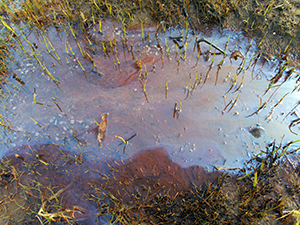One of the most visible and obvious signs of water pollution is an oil sheen. Seeing a shiny, translucent reflection on a pond or lake just looks wrong - but did you know that not all sheens are the result of pollution? Here is what you should know about sheens, how to tell the difference between naturally occurring sheens and those that are the result of pollution, and what you should do if you discover a sheen caused by pollution.
What Is an Oil Sheen?
A sheen is "an iridescent appearance on the surface of the water." The iridescent, lustrous appearance could be caused by a petroleum spill finding its way into the water - or the sheen could be a naturally occurring result of iron bacteria. Iron bacteria are small living organisms which naturally occur in soil, shallow groundwater, and surface waters and are harmless to the environment. Petroleum sheens on the other hand are harmful to the environment and should be reported to the Pennsylvania Department of Environmental Protection (DEP). But how can you tell the difference between the two and what should you do if you discover a sheen caused by pollution?

The Rock Test
A very simple, yet very effective method to tell if an oil sheen is organic or the result of pollution, is to throw a rock into the sheen, or to break it apart with a stick. A bacterial sheen will typically break into small platelets when disturbed while a petroleum sheen will quickly reform. Another way to tell them apart is by smell. Natural sheens don't smell like petroleum.
Reporting
If you have reason to believe the sheen is the result of pollution, you should report it to DEP. An emergency situation, such as an oil spill from a train derailment, should prompt an immediate 911 call. For smaller, less serious sheens, DEP has several reporting methods available. Information on how to submit reports to DEP is available on our Environmental Complaints website. When reporting an incident, note the location, and if possible, take pictures to give a sense of the scale of the problem. After receiving a report, DEP will send an inspector who will collect a sample to analyze.

What You Can Do to Prevent Oil Sheens
The most important thing we all can do to help protect our environment is to not be a source of pollution. Preventing sheens caused by pollution requires safe transportation and disposal of petroleum materials. Oils (and other non-water soluble liquids) should not be dumped into sanitary drains, storm drains or streams. In the workplace, items requiring proper disposal range from lubricants and chemicals used in manufacturing to cooking oil used in restaurants. At home, care must be taken to properly dispose of used motor oil, oil-based paint and so on.
DEP's website offers helpful information on how to properly dispose of items such as these.
Please remember, the next time that you see an oily sheen on surface water, do the rock test to determine if the sheen is organic or the result of pollution and report all pollution sheens to DEP. Thank you for helping to protect our environment!